Magnetic Abrasive Finishing of Beta-Titanium Wire Using Multiple Transfer Movement Method
Abstract
1. Introduction
2. Experimental Equipment and Methods
2.1. Experimental Equipment
2.2. Beta-Titanium Wire Material
2.3. Experimental Methods
3. Experimental Results and Analysis
3.1. Influence of Particle Size
3.2. Influence of Rotational Speed
3.3. Influence of Clearance Distance
3.4. Influence of Multiple Transport Movement
4. Conclusions
- When the grain size of magnetic abrasive material changed at a fixed speed of 1500 rpm, the surface roughness (Ra) was improved to 0.05 μm.
- When the rotational speed was changed and the particle size was fixed at 1 μm, the best results were obtained at a speed of 2000 rpm.
- Better finishing was observed at a finishing gap of 3 mm than 5 mm.
- In all conditions, AFM surface roughness measurements showed that the processed material had a smoother surface than before the machining.
- When finishing using a multi-transfer motion method under optimal conditions, the processing effects were best to worst in the order: vibration with feed rate, vibration only and feed rate only.
- Finally, we found that the magnetic abrasive finishing process using a Nd-Fe-B rare earth permanent magnet showed the best effect when the rotational speed was 2000 rpm and 1 μm abrasive material was used with a 3 mm finishing gap and a multi-transfer motion method.
Author Contributions
Funding
Acknowledgments
Conflicts of Interest
References
- Choi, S.-Y.; Hwang, C.-U.; Kwon, D.-G. Analysis of Machined Surface Morphology According to Changes of Surface Condition in Micro Particle Blasting. Korean Soc. Manuf. Process. Eng. 2018, 17, 70–75. [Google Scholar] [CrossRef]
- Zou, Y.; Xie, H.; Dong, C.; Wu, J. Study on complex micro surface finishing of alumina ceramic by the magnetic abrasive finishing process using alternating magnetic field. Int. J. Adv. Manuf. Technol. 2018, 97, 2193–2202. [Google Scholar] [CrossRef]
- Kaur, M.; Singh, K. Review on titanium and titanium based alloys as biomaterials for orthopaedic applications. Mater. Sci. Eng. C 2019, 102, 844–862. [Google Scholar] [CrossRef] [PubMed]
- Heng, L.; Yin, C.; Han, S.H.; Song, J.H.; Mun, S.D. Development of a New Ultra-High-Precision Magnetic Abrasive Finishing for Wire Material Using a Rotating Magnetic Field. Materials 2019, 12, 312. [Google Scholar] [CrossRef] [PubMed]
- Wu, J.; Zou, Y.; Sugiyama, H. Study on finishing characteristics of magnetic abrasive finishing process using low-frequency alternating magnetic field. Int. J. Adv. Manuf. Technol. 2015, 85, 585–594. [Google Scholar] [CrossRef]
- Singh, G.; Singh, A.K.; Garg, P. Development of magnetorheological finishing process for external cylindrical surfaces. Mater. Manuf. Process. 2017, 32, 581–588. [Google Scholar] [CrossRef]
- Heng, L.; Yang, G.E.; Wang, R.; Kim, M.S.; Mun, S.D. Effect of carbon nano tube (CNT) particles in magnetic abrasive finishing of Mg alloy bars. J. Mech. Sci. Technol. 2015, 29, 5325–5333. [Google Scholar] [CrossRef]
- Chang, G.-W.; Yan, B.-H.; Hsu, R.-T. Study on cylindrical magnetic abrasive finishing using unbonded magnetic abrasives. Int. J. Mach. Tools Manuf. 2002, 42, 575–583. [Google Scholar] [CrossRef]
- Parameswari, G.; Jain, V.K.; Ramkumar, J.; Nagdeve, L. Experimental investigations into nanofinishing of Ti6Al4V flat disc using magnetorheological finishing process. Int. J. Adv. Manuf. Technol. 2017, 100, 1055–1065. [Google Scholar] [CrossRef]
- Choi, S.-Y.; Kwon, D.K. A Study of the Effectives for Surface Roughness by Cutting Angle and Cutting Fluid. Korean Soc. Manuf. Process. Eng. 2018, 17, 57–62. [Google Scholar] [CrossRef]
- Bae, J.-K.; Ahn, D.-H.; Kwon, B.-C.; Ko, S.L. Development of Efficient Brush Deburring Process for Valve Body of Auto Transmission. Korean Soc. Manuf. Process. Eng. 2018, 17, 144–152. [Google Scholar] [CrossRef]
- Yin, C.; Heng, L.; Kim, J.S.; Kim, M.S.; Mun, S.D. Development of a New Ecological Magnetic Abrasive Tool for Finishing Bio-Wire Material. Materials 2019, 12, 714. [Google Scholar] [CrossRef] [PubMed]
- Alam, Z.; Khan, D.A.; Jha, S. A study on the effect of polishing fluid volume in ball end magnetorheological finishing process. Mater. Manuf. Process. 2017, 33, 1197–1204. [Google Scholar] [CrossRef]
- Liu, S.; Shan, X.; Guo, K.; Yang, Y.; Xie, T. Experimental study on titanium wire drawing with ultrasonic vibration. Ultrasonics 2018, 83, 60–67. [Google Scholar] [CrossRef] [PubMed]
- Song, J.; Shinmura, T.; Mun, S.D.; Sun, M. Micro-Machining Characteristics in High-Speed Magnetic Abrasive Finishing for Fine Ceramic Bar. Metals 2020, 10, 464. [Google Scholar] [CrossRef]
- Nagdeve, L.; Sidpara, A.M.; Jain, V.K.; Ramkumar, J. On the effect of relative size of magnetic particles and abrasive particles in MR fluid-based finishing process. Mach. Sci. Technol. 2017, 22, 493–506. [Google Scholar] [CrossRef]
- Zeng, Z.; Cong, B.; Oliveira, J.; Ke, W.; Schell, N.; Peng, B.; Qi, Z.; Ge, F.; Zhang, W.; Ao, S. Wire and arc additive manufacturing of a Ni-rich NiTi shape memory alloy: Microstructure and mechanical properties. Addit. Manuf. 2020, 32, 101051. [Google Scholar] [CrossRef]

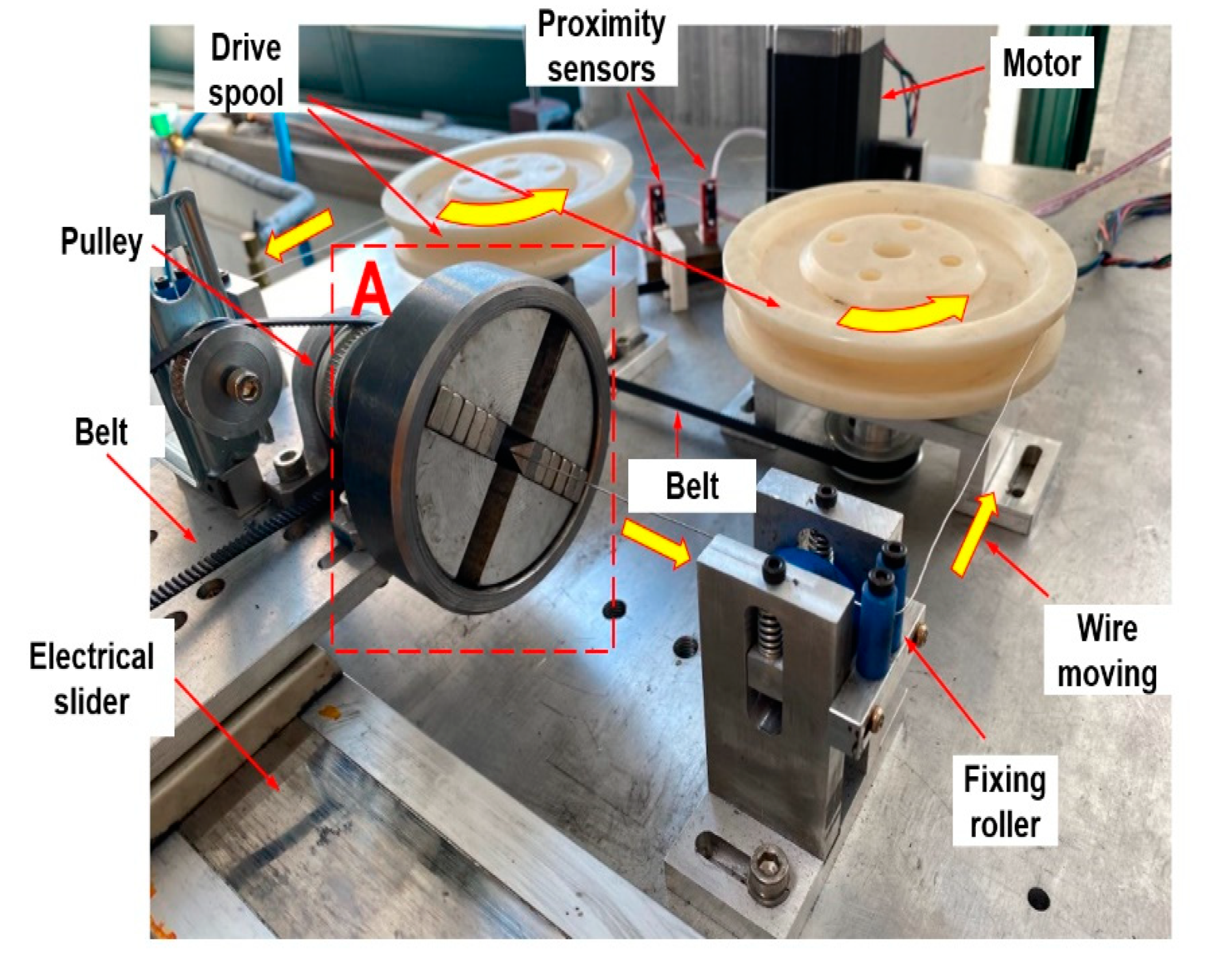
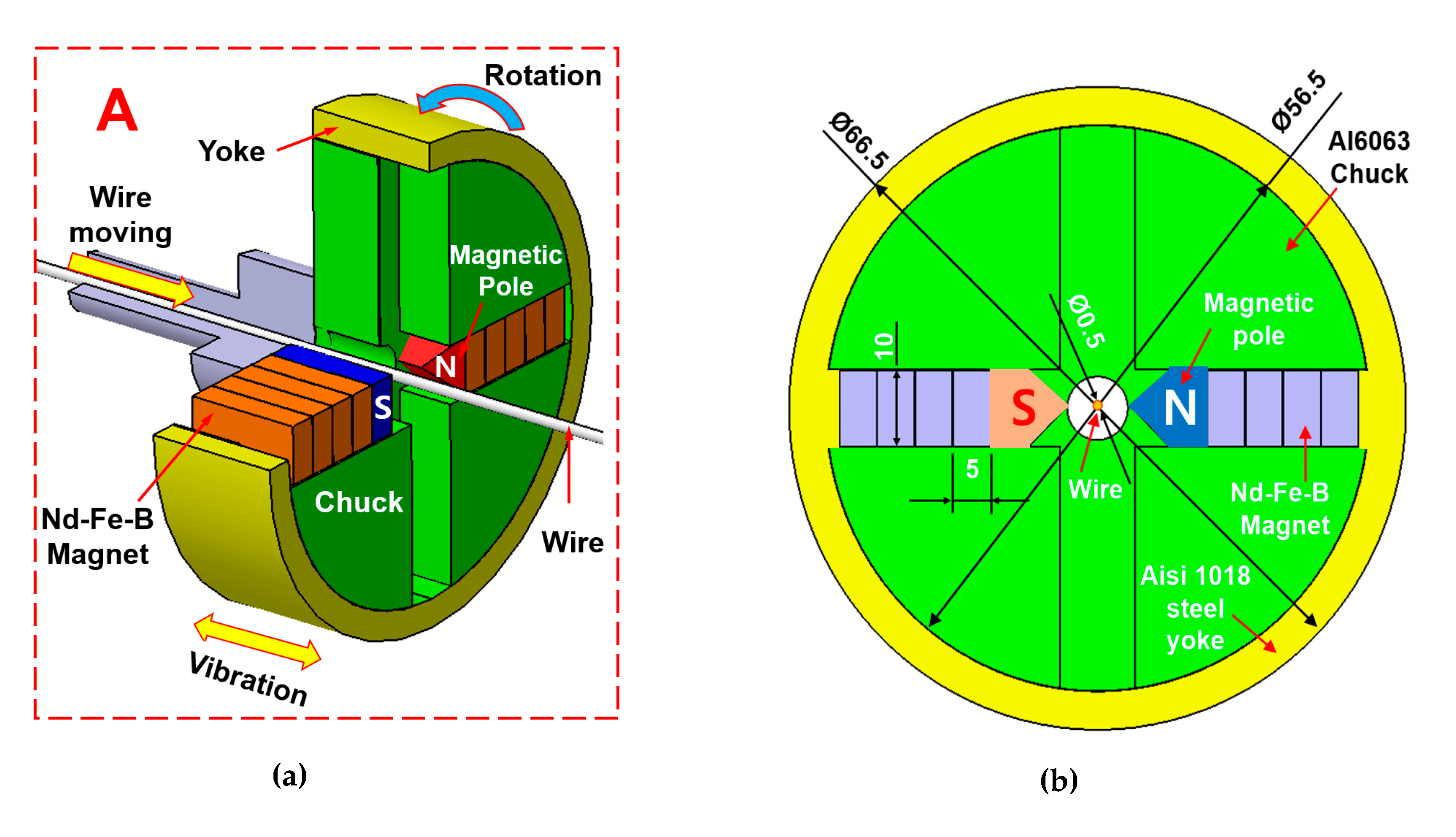
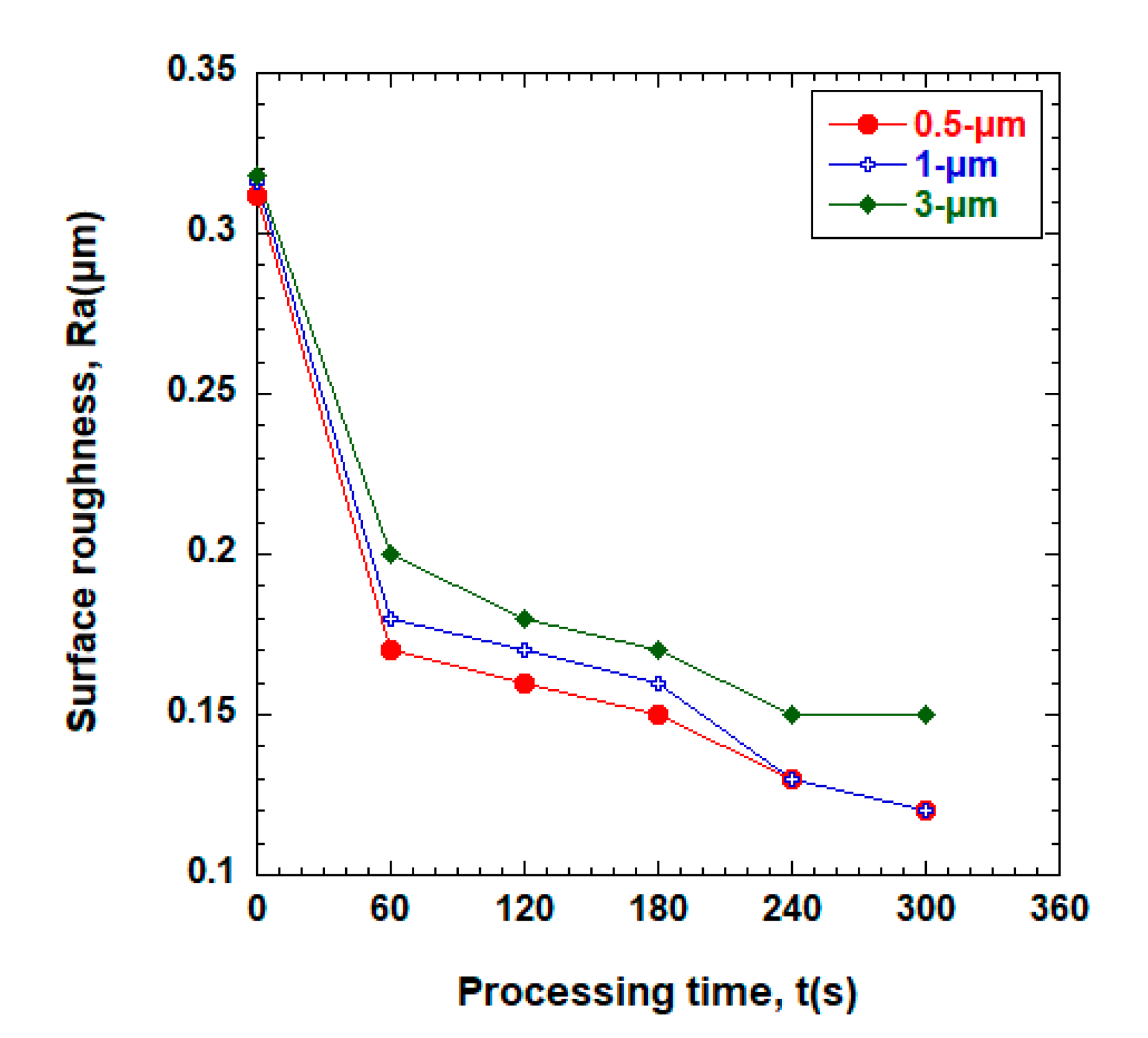
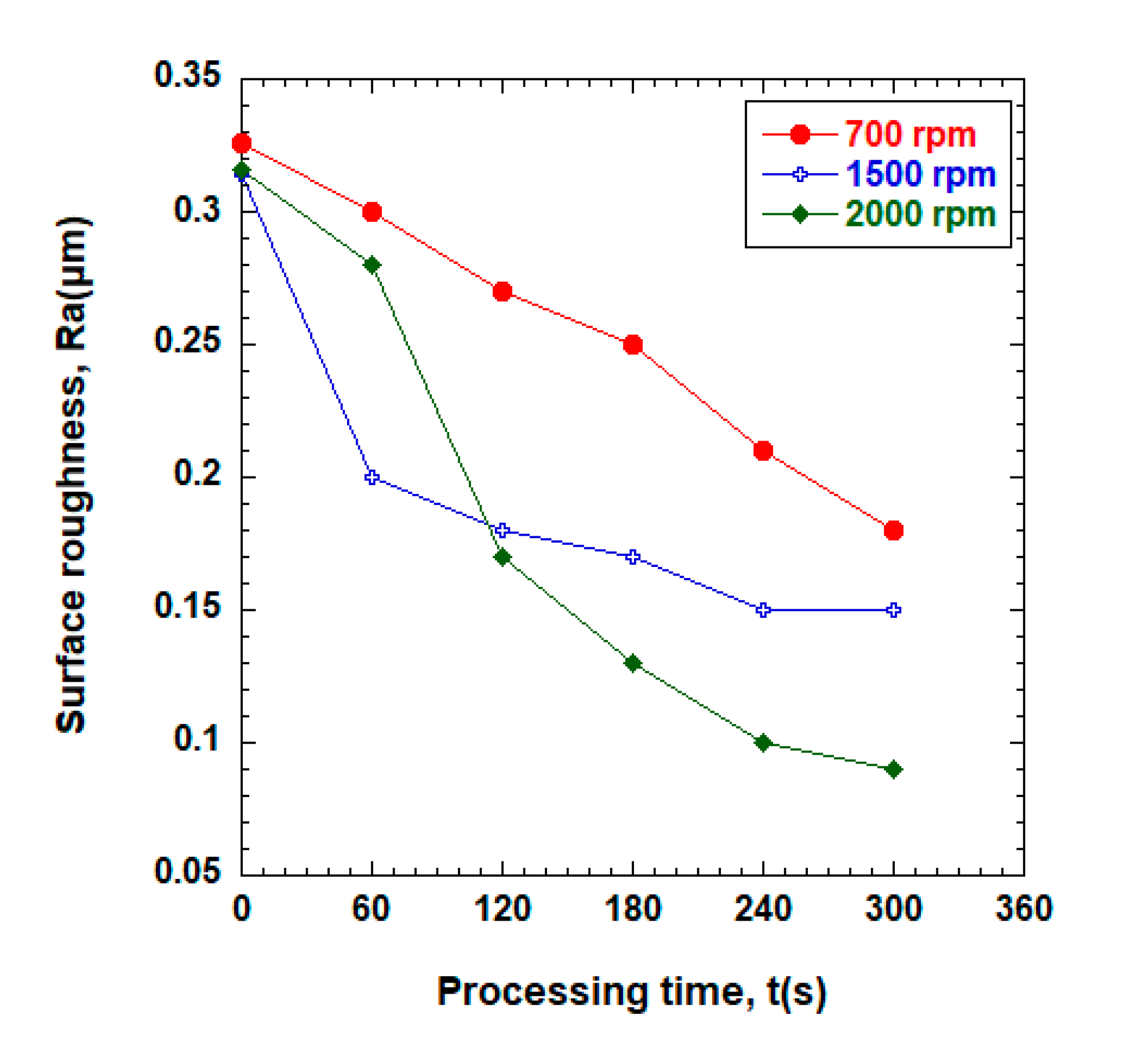



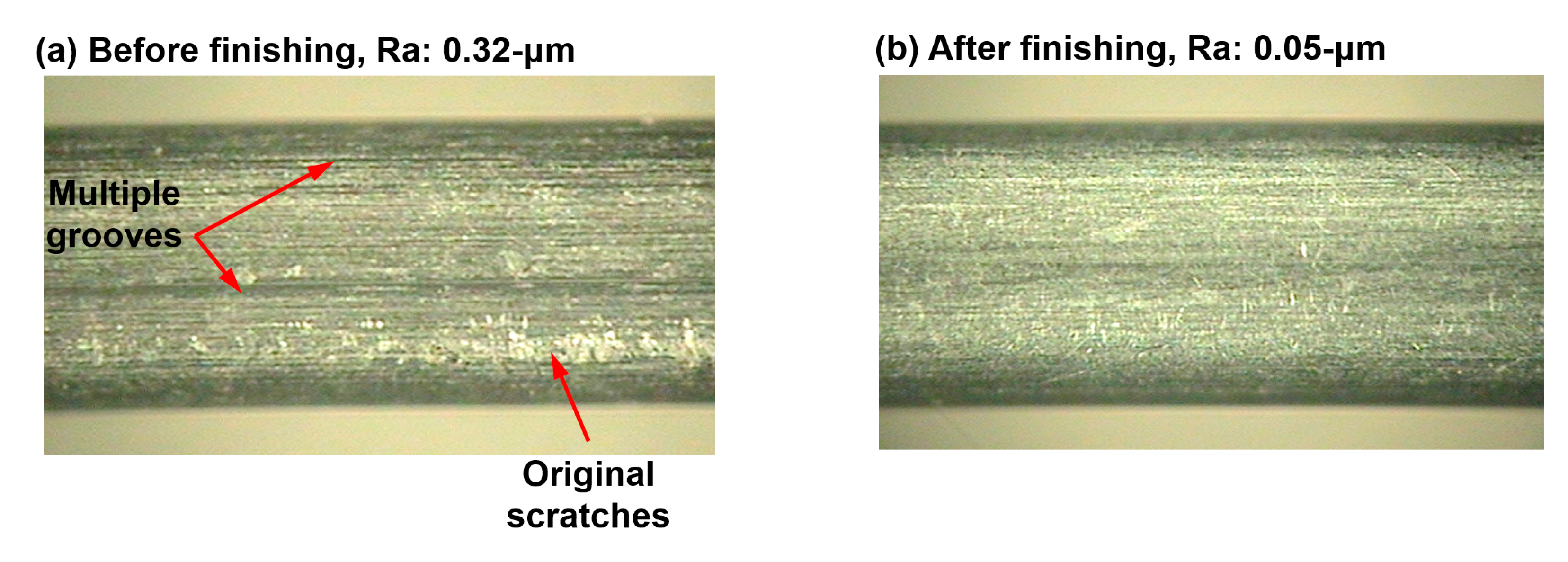
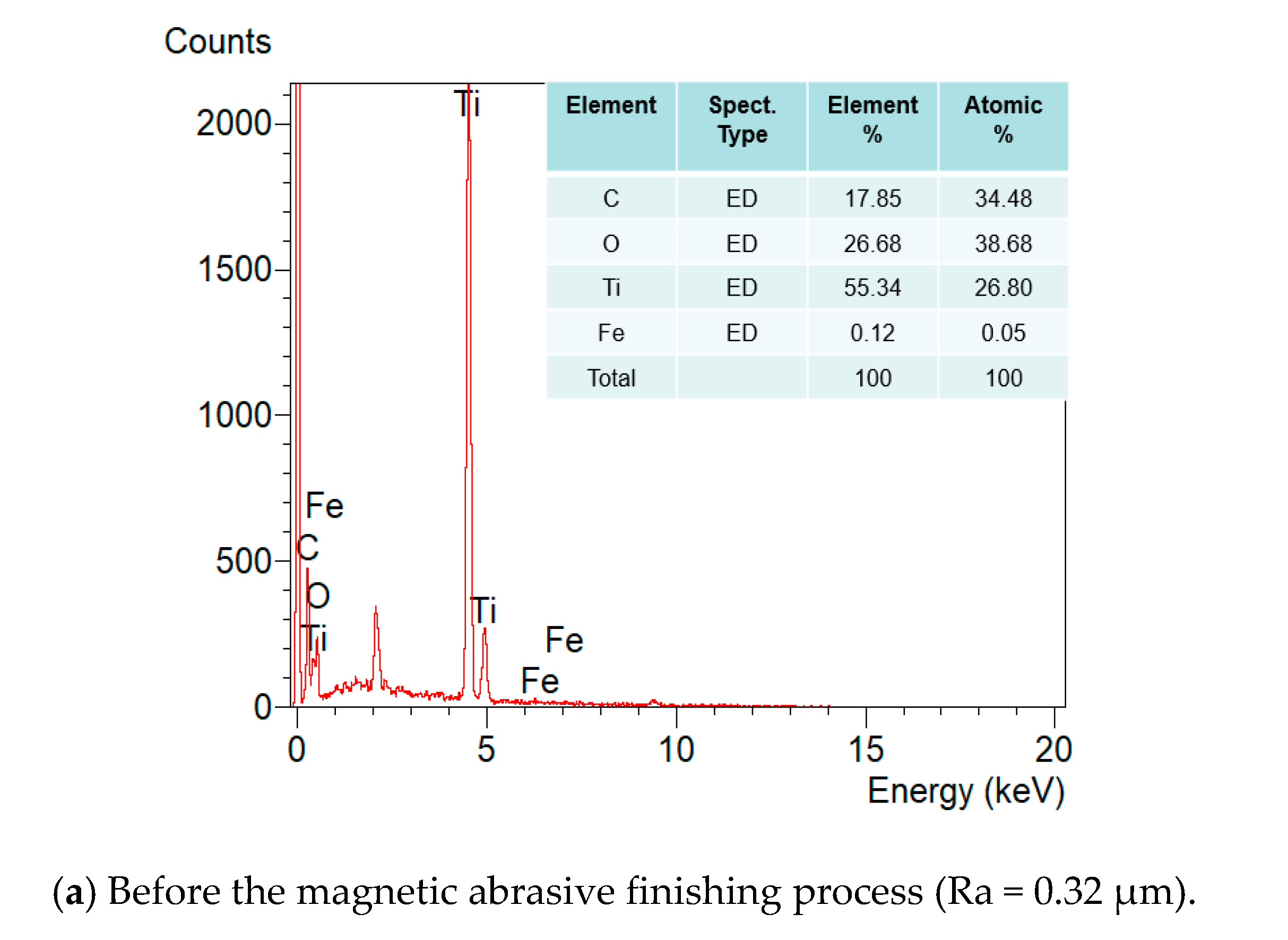
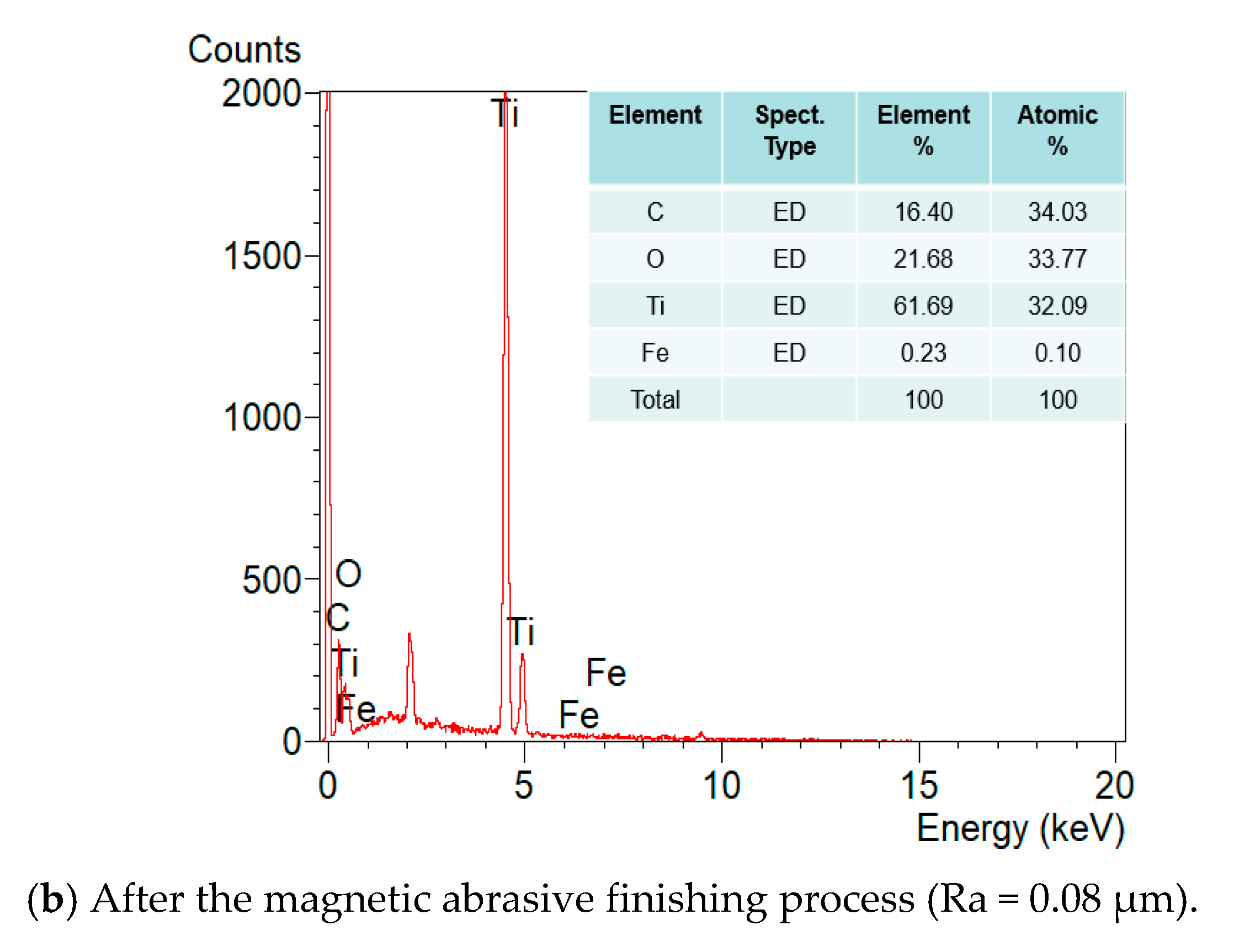
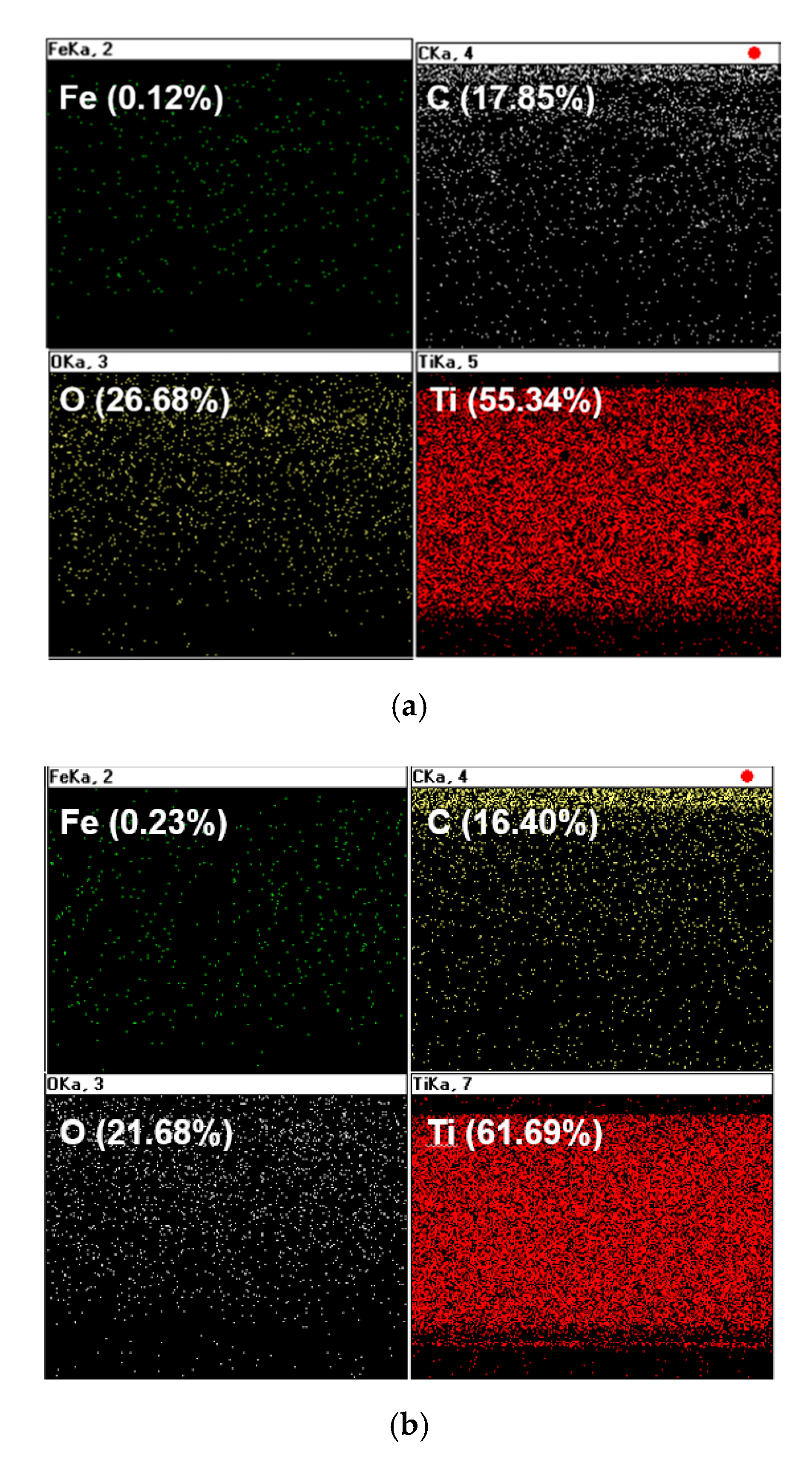
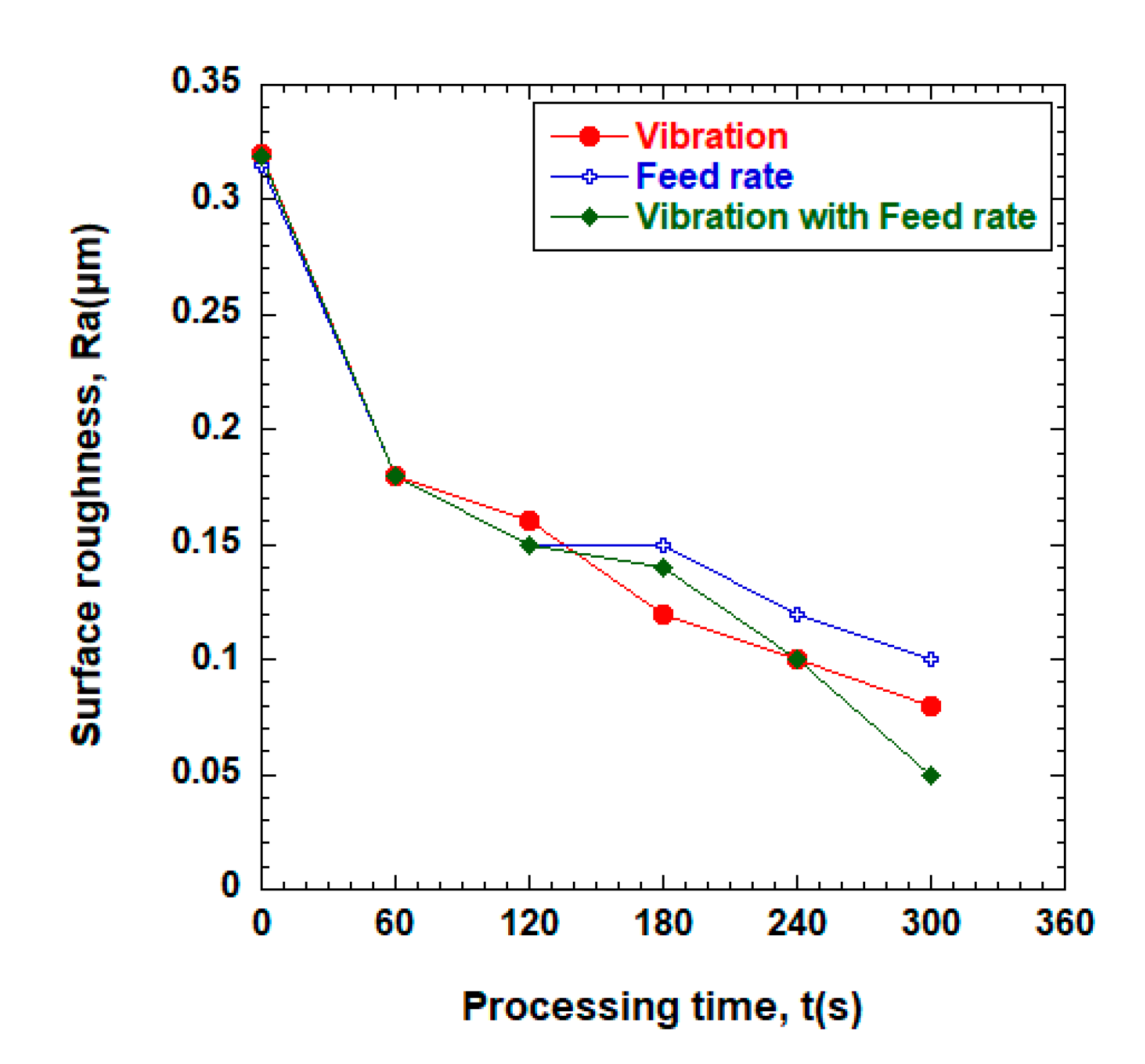

| Component | N | C | H |
| Chemical composition (Max%) | 0.03 | 0.08 | 0.015 |
| Component | O | Fe | Ti |
| Chemical composition (Max%) | 0.18 | 0.2 | Remainder |
| Mechanical Properties | Matrix |
|---|---|
| Tensile strength (MPa) | 345 |
| Yield strength (MPa) | 220 |
| Elongation (%) | 35 |
| Hardness (HV) | 115 |
| Elastic modulus (GPa) | 115 |
| Density (g/m3) | 4.51 |
| Workpiece material | β-titanium wire (L = 50 mm, D = 0.5 mm) |
| Electrolytic iron powder | 1.2 g (#200) |
| Diamond paste (PCD) | (0.5, 1, and 3 μm) 0.6 g |
| CNT particle | 0.02 g |
| Lubricant | 0.3 mL (light oil) |
| Magnet | Nd-Fe-B permanent magnet (Size: 20 mm × 10 mm × 10 mm) |
| Magnetic pole vibration | Amplitude: 2 mm |
| Finishing gap | 3 mm, 5 mm |
| Rotational speed | 700, 1500, 2000 rpm |
| Finishing time | 0, 60, 120, 180, 240, 300 s |
| Vibration frequency | 8 Hz |
| Feed rate | 80 mm/min |
| Element | Chemical Composition (%) before Processing | Chemical Composition (%) after Processing |
|---|---|---|
| C | 17.85 | 16.40 |
| O | 26.68 | 21.68 |
| Ti | 55.34 | 61.69 |
| Fe | 0.12 | 0.23 |
| Total | 100 | 100 |
© 2020 by the authors. Licensee MDPI, Basel, Switzerland. This article is an open access article distributed under the terms and conditions of the Creative Commons Attribution (CC BY) license (http://creativecommons.org/licenses/by/4.0/).
Share and Cite
Nam, S.S.; Kim, J.S.; Mun, S.D. Magnetic Abrasive Finishing of Beta-Titanium Wire Using Multiple Transfer Movement Method. Appl. Sci. 2020, 10, 6729. https://doi.org/10.3390/app10196729
Nam SS, Kim JS, Mun SD. Magnetic Abrasive Finishing of Beta-Titanium Wire Using Multiple Transfer Movement Method. Applied Sciences. 2020; 10(19):6729. https://doi.org/10.3390/app10196729
Chicago/Turabian StyleNam, Sung Sik, Jeong Su Kim, and Sang Don Mun. 2020. "Magnetic Abrasive Finishing of Beta-Titanium Wire Using Multiple Transfer Movement Method" Applied Sciences 10, no. 19: 6729. https://doi.org/10.3390/app10196729
APA StyleNam, S. S., Kim, J. S., & Mun, S. D. (2020). Magnetic Abrasive Finishing of Beta-Titanium Wire Using Multiple Transfer Movement Method. Applied Sciences, 10(19), 6729. https://doi.org/10.3390/app10196729




